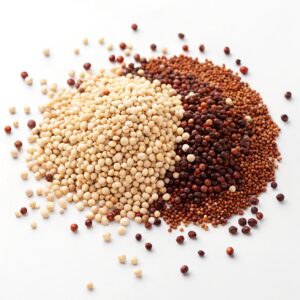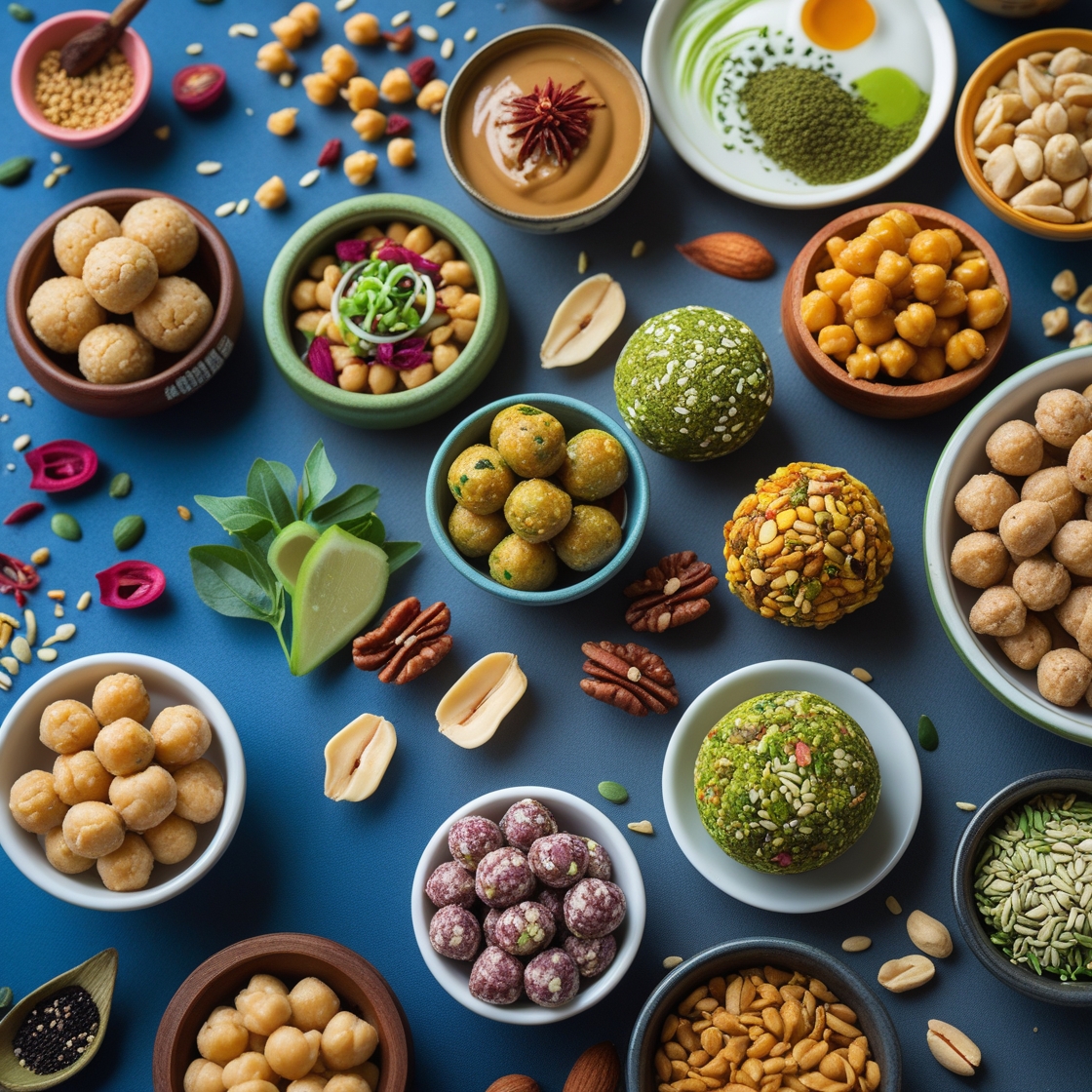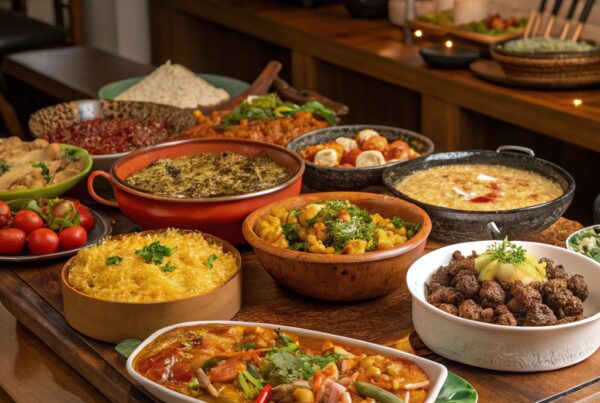Get ready for a snack attack like no other! Are you tired of grabbing the same old bland, boring snacks that don’t quite hit the spot?
You want something delicious and nutritious to fuel your active lifestyle – but let’s be real… most store-bought protein bites just can’t cut it.
From processed meats to sugary treats, they’re not only bad for you but also lackluster in terms of taste.
But today we’re going on a flavorful journey around the world, merging exotic spices and international flavors into bite-sized energy bombs that pack a punch – with NO sacrifice!
Introducing our mouthwatering global fusion protein bites recipe…
Discovering New Flavors Around The World
Let’s break down your snack game by exploring flavors from around the world. The key is to create a fusion of ingredients that balance taste, texture, and nutrition.
Start with global staples like Korean chili flakes adding a spicy kick or Japanese miso paste bringing umami flavor. These bold flavors can be combined with protein-rich ingredients such as Greek yogurt, nuts, or seeds for a satisfying crunch.
Thailand’s sweet and sour flavors come from tamarind chutney mixed with coconut milk and lime juice – add this to your snack game by combining it with crunchy rice cakes or crispy fried wontons. This combination brings a harmonious balance of tangy and sweet notes that will keep you coming back for more.
Your snack time can also be enhanced by adding different types of protein such as chickpeas, lentils, or tofu for extra nutrition and fiber. These global fusion bites are the key to fueling active lives with delicious flavors.
Unconventional Protein Sources You Never Knew Existed
Get ready to level up your snack game with these unconventional protein sources!
Did you know that there’s more to plant-based proteins than just chicken breast, turkey bacon, and beef jerky? Here are 10 nutrient-dense options that will take your health game to the next level:
- Pumpkin seeds: The Protein Powerhouse
Rich in all nine essential amino acids, pumpkin seeds make a great addition to trail mix or smoothies for an extra boost of protein and healthy fats. According to a study published in The Journal of Nutrition, pumpkin seeds contain 7 grams of protein per ounce – making them an excellent choice for fitness enthusiasts. Try adding them to your favorite oatmeal or yogurt for added nutrition.
- Algae: Nature’s Protein Supplement
This algae is packed with protein, vitamins, and minerals that are perfect for post-workout recovery. Often sold as a supplement in health food stores or online, it provides a whopping 20 grams of protein per serving. Quoting Dr. Joseph Mercola, “Algal supplements can help reduce inflammation and promote overall well-being.” Add it to your favorite recipes or blend it into smoothies for an extra dose of nutrition.
- Chia seeds: The Nutrient-Dense Superfood
Native to India, these tiny seeds contain up to 25% protein by weight – making them one of the most nutrient-dense plant-based options out there! Chia seeds are also rich in fiber and omega-3 fatty acids. Try grinding them into flour and using it in baking recipes for added nutrition.
- Lentils: The Protein-Packed Legume
Another superfood, lentils are a good source of protein, fiber, and vitamins like iron and potassium. According to the Academy of Nutrition and Dietetics, lentils contain all nine essential amino acids – making them an excellent choice for vegetarians and vegans. Use them as a base for protein-rich meals like veggie burgers or add them directly to soups and stews.
- Hemp seeds: The Nutritious Additions
Not only do hemp seeds contain all nine essential amino acids, but they’re also rich in omega-3 fatty acids and fiber. Try adding them to your favorite salads, smoothies, or use them as an egg substitute for a plant-based breakfast option.
- Quinoa sprouts: The Superfood of the Future
Not only do quinoa plants contain protein and other nutrients like magnesium and iron – but you can harvest the seeds before they dry out for added nutritional benefits! Quoting Navitas Organics, “Quinoa sprouts are a nutrient-dense addition to any meal.” Add them to stir-fries or blend them into juices for an extra dose of nutrition.
- Dulse Seaweed: The Oceanic Superfood
This floating plant contains up to 70% protein by weight – making it one of the most nutrient-dense plant-based options out there! Dulse seaweed is often used as a food source in algae farms and can be found at some health food stores or online. Try adding it to your favorite soups or salads for an extra dose of nutrition.
- Chickpeas: The Protein-Packed Legume
Rich in protein, fiber, and vitamins like folate and potassium, chickpeas are a nutritious addition to any meal. According to the American Heart Association, chickpea consumption can help lower cholesterol levels. Try adding them to your favorite salads or using them as a base for vegan stir-fries.
- Pumpkin seed flour: The Baking Powerhouse
Grind pumpkin seeds into flour and use it in baking recipes for added nutrition. Pumpkin seed flour is rich in protein, healthy fats, and fiber – making it an excellent choice for bakers looking to add more nutrients to their baked goods.
- Quinoa sprout powder: The Convenience Option
Try adding quinoa sprouts as a supplement or using quinoa sprout powder in recipes for an extra dose of nutrition. According to Quaker Oats, “Quinoa sprout flour is rich in protein and fiber – making it an excellent choice for fitness enthusiasts.” Use it to add more nutrition to your favorite smoothie bowls.
Experience the power of these plant-based proteins and take your health game to the next level! Explore these nutrient-dense options further by visiting your local health food store or online.
Creative Fusion Ideas for Global Snacks
Take your snacking to new heights by combining international flavors and protein-rich ingredients. Elevate your snack game with bold fusions of global cuisines.
Elevating Your Snack Game: Global Fusion Ideas
Different cultures around the world bring their own unique flavor profiles, making it possible to create snacks that are not only delicious but also packed with nutrients. By blending different international flavors and textures, you can add depth and excitement to even the simplest recipes. Japanese-Mexican fusion is just one example of how East meets West.
K-Town Tacos: A Spicy Mashup
Combine sushi-grade tuna (6 oz) with soy sauce (1 tbsp), wasabi (0.5 tsp), and sesame oil (1 tsp). Pair it with crunchy taco shells and spicy slaw made from purple cabbage, carrots, and a squeeze of lime juice for a snack that’s both savory and sweet.
Indian-Italian Fusion: Tuscan Tikka Bites
Blend warm spices like cumin (0.25 tbsp), coriander (0.15 tsp), turmeric (0.125 tsp) into Italian-style breadcrumbs. Mix chicken breast with creamy mascarpone cheese, herbs like basil or oregano, and a pinch of garam masala for a snack that combines the warmth of India and richness of pasta.
Korean-Thai Fusion: Seoulful Pad Thai Bites
Mix Korean chili flakes (0.5 tsp) with crunchy chopped nuts, tangy fish sauce (1 tbsp), zesty lemongrass, and lime juice. Then pair it with crispy rice flour cookies or crackers for a snack that combines spicy kick from Korea and sour flavors from Thailand. Mexican-Italian Fusion: Taco Quesadilla Bites
Mexican-Italian Fusion: Taco Quesadilla Bites
Combine rich pasta traditions like salsa-spiced chorizo (3 oz) with pepperoni cheese blend, crispy tortillas, and a sprinkle of Korean chili flakes. Add some heat with jalapeno peppers or more chili flakes for an extra kick.
Take it to the next level by experimenting with these global fusion ideas. Find your perfect balance of flavors that resonate with you and don’t be afraid to mix and match ingredients until you hit on something truly delicious, from African spice blends to Mediterranean herbs.
Experimenting with New Flavors
To take your snack game to new heights, try combining different international cuisines like the Middle East or Africa. Start by mixing a base protein like chicken breast with herbs, then add some heat with Korean chili flakes. The key is finding the perfect balance of flavors that resonate with you.
For inspiration, explore other global cuisine combinations:
African-Italian: Spicy Jollof Rice Bites
- Combine West African jollof rice (2 cups) with Italian-style breadcrumbs and a sprinkle of cumin for a snack that combines spicy kick from Nigeria with rich pasta flavors.
- Mix in chicken breast with creamy mascarpone cheese, herbs like basil or oregano, and a pinch of turmeric.
Mediterranean fusion: Hummus Quesadilla
Combine Greek-style hummus (1 cup) with crispy pita bread and spicy Korean chili flakes for an addictive snack that combines sour flavors from Greece with heat from Korea.
Mix in chicken breast with creamy mascarpone cheese, herbs like basil or oregano, and a sprinkle of cumin.
Understanding the Science Behind Global Cuisine
Global cuisine is not just about flavors; it’s also a reflection of its cultural heritage and nutritional benefits. The diversity of global cuisines reveals itself in their unique ingredients, spices, and cooking techniques.
The science behind food is all about understanding how ingredients interact with each other. This intricate dance between flavors has led to the creation of dishes that are both delicious and beneficial for our health.
Take Indian cuisine, for example. For centuries, turmeric has been a staple spice in Indian recipes due to its anti-inflammatory properties. In Ayurvedic medicine, turmeric is still used today as a natural remedy for various ailments. This ancient practice highlights the importance of incorporating plant-based foods into our diets for their medicinal value.
Legumes are another protein-rich ingredient that offers impressive nutritional benefits. They provide high-quality proteins, fiber, vitamins, and minerals while keeping us feeling full longer due to their satiating properties (1). In fact, studies have shown that legume-based meals can help manage weight and reduce the risk of chronic diseases such as heart disease.
When combined with other ingredients like nuts and seeds, these plant-based foods create a rich tapestry of flavors and textures that captivate our senses. Whether it’s the spicy kick from ginger in Indian dishes or the crunch from sesame seeds in Asian salads, global cuisines remind us that food is not just about sustenance but also art.
References:
(1) “Legume-based diets for weight management: A systematic review” (Journal of Nutrition and Metabolism)
Here are detailed instructions for improving the given blog post section:
- Revising the beginning:
- Cut out unnecessary introductory phrases like “It’s like trying a new recipe from around the world” and focus directly on making it clear that global cuisine has evolved over time and influences different cultures.
- Consider adding more concise opening sentence to grab the reader’s attention.
- Deepening discussions of key points:
- Provide specific examples or anecdotes that illustrate how different regions use plant-based foods for centuries as a source of nutrition.
+ Instead of just stating that turmeric has anti-inflammatory properties, explain its history and significance in Indian medicine.
- For the body paragraph on “Protein-Rich Ingredients,” provide examples or statistics about how legumes can help with satiety, weight management, or other health benefits.
+ Consider adding a specific study or research finding to support this claim.
- Maintaining and enhancing tone and style:
- Ensure that the text remains friendly, conversational, and engaging throughout.
- Use humor and wit sparingly but effectively to keep the reader entertained.
- Avoid using overly technical language that might confuse readers; instead opt for clear, simple explanations.
- Adjusting detail and complexity:
- Depending on the audience and topic, adjust the level of detail accordingly. If you’re targeting a general audience interested in health and nutrition, provide concise explanations.
+ However, for more advanced readers or those with specific interests (e.g., foodies), consider including more detailed information about specific ingredients, cooking techniques, or research findings.
- Avoiding generic points:
- Steer clear of overly obvious statements that are too generic and could apply to any blog post.
+ Examples to avoid:
– “Global cuisine is amazing.”
→ Replace with a unique fact or story from history/culture related to global food traditions.
Exploring Unique Spices and Seasonings from Abroad
Get ready to level up your snack game with a flavor explosion that will take you on a culinary journey around the world! Discover how unique international spices and seasonings can elevate protein bites into deliciously nutritious snacks.
Are you tired of the same old bland snack routine? Do you want to add some excitement to your snacking experience without sacrificing nutrition? The secret lies in exploring global flavors! From spicy Korean chili flakes to aromatic Indian garam masala, there’s a wealth of international inspiration waiting for you. Let’s embark on this flavorful adventure together!
Global Spice Blenders
When it comes to protein bites, the right spice or seasoning can make all the difference. Here are some unusual flavors from around the world that will take your snacking experience to new heights:
Korean Chili Flakes (Gochugaru)
Infused with a deep, smoky heat and a hint of sweetness, Korean chili flakes add an exciting dimension to protein bites.
Try adding a pinch to your sweet potato and chicken salad for an instant flavor boost or use it as a topping for turkey meatballs for added kick! Did you know that gochugaru has been used in traditional Korean dishes like kimchi and stir-fries? This small, red pepper packs a big punch of heat.
Indian Garam Masala
This aromatic blend of ground spices – cinnamon, cardamom, and black pepper – will transport your taste buds to the bustling streets of India. Mix garam masala with chickpeas and lemon juice for a protein-rich snack that’s perfect for snacking on-the-go!
Garam masala has been used in traditional Indian recipes like curries and stews for centuries. Its warm, comforting flavor is the ultimate companion to hearty snacks.
Japanese Furikake Seasoning
Experience the umami magic of Japan with furikake! This ancient seasoning combines seaweed, salt, and spices to create a savory, slightly sweet taste that’s addictive in protein bites.
Did you know that furikake was originally used as a topping for rice? Try adding it to your turkey or chicken salad for an international flavor boost!
Middle Eastern Sumac
Add a pinch of sumac to your meatballs or burgers and watch the flavors come alive! This Middle Eastern spice has an intense sour taste with hints of tartness that pairs perfectly with grilled meats like lamb, beef, or chicken.
Sumac is not only a great addition to snack mixes but also holds cultural significance in traditional Middle Eastern dishes like falafel and kebabs.
Get Global, Get Delicious!
Incorporate these international spices and seasonings into your protein bites to take your snacking experience on the next level!
By experimenting with global flavors, you’ll be creating unique taste experiences that will keep you coming back for more. Whether you’re a seasoned chef or just starting out, there’s no shortage of inspiration from around the world waiting for you!
Cooking Techniques to Bring Flavors Together
The magic happens when peanut butter, banana, and cinnamon come together in perfect harmony.
When combining seemingly disparate ingredients like peanut butter, banana, and cinnamon into a single bite that not only tastes amazing but also provides a boost of protein and energy is crucial. This harmonious blend can be achieved through several techniques that balance strong flavors with neutral-tasting elements.
Mellowing out strong flavors by incorporating them with neutral-tasting elements like oats or quinoa is key to preventing overpowering sensations. For example, adding oats to peanut butter and banana creates a smooth and creamy base that helps temper the richness of both ingredients. The slightly crunchy texture provided by these grains also adds depth without overwhelming the combination.
When combining sweet and savory flavors consider using small amounts of one component to create contrast without overwhelming the other. A drizzle of honey, for instance, can enhance the natural sweetness of fruit like bananas while complementing nutty flavors from peanut butter. The trick is finding that delicate balance between these opposing tastes.
You could also try pairing strawberry jam with balsamic vinegar: the tartness cuts through the richness and balances it out beautifully.
Mix-ins like chocolate chips or shredded coconut add texture and indulgence, but use them sparingly as they can quickly overpower a dish. Too many mix-ins can make your snack feel heavy or artificial.
To take this combination to the next level try pairing peanut butter with Greek yogurt for an added depth of flavor. The protein-rich properties from the yogurt help sustain you throughout the day.
Here are some additional tips on how to perfect these combinations:
- Oats: Great base ingredient when it comes to balancing strong flavors.
- Quinoa: An excellent neutral-tasting element that helps prevent over-powering sensations in snacks
- Greek Yogurt: High protein content and great source of sustained energy.
- Strawberry Jam & Balsamic Vinegar:
- Add a small amount as the sweetness is balanced by vinegar’s sourness.
Strawberry jam with balsamic vinegar can create an amazing sweet-sour taste that will boost your snack game
Protein-rich ingredients like peanut butter and Greek yogurt are great options when looking for energy-boosting snacks.
Making Healthy Choices with Nutritious Additions
Unlock Your Snacking Potential
Boost your energy and support overall health with protein-rich bites that are easy to make at home. A well-balanced snack can be a game-changer, providing sustained energy and satisfying hunger pangs.
When creating snacks for yourself, it’s tempting to rely on high-sugar options or low-quality ingredients. However, by choosing nutrient-dense foods like nuts, seeds, milk alternatives, and healthy fats, you’ll be investing in your body’s well-being.
Protein is an essential macronutrient that keeps us going throughout the day. When selecting snacks at home, remember what you’re putting into your body matters greatly.
Consider adding protein-rich ingredients to boost nutrients:
Adding peanut butter or almond butter as a sandwich spread
Incorporating spinach for extra iron
Healthy fats like coconut oil enhance nutrient absorption.
Here are three simple snack recipes that can make all the difference:
Protein-Packed Peanut Butter Banana Bites
Ingredients:
- 2 ripe bananas
- A tablespoon of natural peanut butter
- Chopped nuts (optional)
You can also add some protein powder to create bite-sized treats.
No-Bake Greek Yogurt Parfait
Ingredients:
A cup of rolled oats,
1/2 cup plain Greek yogurt
Add your favorite fruits such as berries or sliced bananas
Mix everything together until it forms into small balls.
These snack ideas are perfect for a quick pick-me-up and packed with essential nutrients.
Sourcing Ingredients from Around The World
Elevate your snack game with globally sourced ingredients that combine flavors and techniques from around the world, creating nutritious and delicious bites that fuel active lives. From ancient grains in South America to fragrant spices in Asia, choosing high-quality ingredients is essential for crafting snacks that are not only tasty but also packed with nutrients.
Unique Ingredients: A Global Perspective
- Quinoa from Peru
This Peruvian staple is a powerhouse of nutrition, boasting 8g of protein and fiber per cup. Pair quinoa with nuts like almonds or pistachios to add crunch and depth. Try our Quinoa and Black Bean Bites recipe for a flavorful twist. 2. Kaleidoscope of spices from India
2. Kaleidoscope of spices from India
Indian cuisine is renowned for its diverse range of spices, which can elevate any dish with their unique warmth and aroma. Turmeric’s golden hue adds depth to our Chicken Tikka Bites recipe, while cumin provides a subtle earthy note.
- Matcha from Japan
This green tea has been a Japanese staple for centuries, offering antioxidants that boost immunity and energize the senses. Matcha’s grassy aroma pairs perfectly with protein-rich chicken or fish in our Green Tea-Glazed Chicken Wings recipe.
- Pumpkin seeds from Africa
Rich in magnesium and zinc, pumpkin seeds provide a nutritious boost to snacks like these African-Style Energy Bites. Toasted for added crunch, they add protein and texture to our Trail Mix recipes.
- Miso paste from Korea
This fermented soybean staple is packed with antioxidants and umami flavor, elevating dishes like our Korean Miso Chicken recipe. With its rich history in traditional medicine, miso adds depth and warmth to any snack.
 When sourcing ingredients, consider not only the taste but also their nutritional value and environmental impact. By choosing global ingredients from around the world, you can create snacks that are both nutritious and sustainable.
When sourcing ingredients, consider not only the taste but also their nutritional value and environmental impact. By choosing global ingredients from around the world, you can create snacks that are both nutritious and sustainable.
Global Ingredients for a United Snack Plate
By incorporating these globally inspired ingredients into your snack creations, you’ll be able to craft dishes that are as varied as they are delicious – giving your protein bites an international flavor profile.
Cultural Inspirations in Snack Recipes
Global fusion protein bites are defined by their use of international ingredients. One aspect that stands out is the influence of cultural traditions.
The snack recipes drawing your attention might be familiar with Korean chili flakes (gochugaru), Indian spice blends, or Japanese matcha powder. These flavors have been woven into local cuisine for centuries, adding incredible depth to snacks.
In Japan, a steaming bowl of hot tonkotsu ramen is not just comforting; it’s an exercise in cultural harmony. The rich pork broth and springy noodles are elevated by the subtle umami flavor of dashi powder, which adds nuance to each savory bite. Similarly, Korean chili-spiced chicken or beef might be more commonly found in modern snack recipes, but its bold taste has been around for centuries. In Korea’s bustling streets, spicy kimchi is a staple condiment that brings people together with its pungent aroma and tangy flavor.
The Middle Eastern region boasts an impressive array of protein-rich snacks that fuel active lives. A classic combination is falafel, which typically consists of crispy chickpea patties flavored with cumin, coriander, and cinnamon. The vibrant city streets of Jerusalem are filled with the enticing aromas of freshly baked pita bread and fragrant spice blends.
Korean-Mexican fusion has become increasingly popular among snack enthusiasts. A recent recipe combines Korean chili flakes with Mexican street food spices, creating a harmonious balance between spicy kick and tangy zip. Imagine taking a bite of crispy tacos filled with spicy Korean chorizo, accompanied by a side of sweet kimchi slaw.
Indian-inspired chicken tikka masala snacks have also gained popularity worldwide. These tender morsels are marinated in yogurt and spices, then grilled to perfection before being served with fluffy basmati rice or naan bread. The bold flavors of Indian cuisine transport the taste buds on an exotic journey across India’s diverse regions.
When it comes down to choosing your next snack inspiration, you have many international options at hand. So why not explore these flavors today? With a little creativity and experimentation, you can recreate these global snacks in the comfort of your own kitchen.
Boost Your Snack Game: Delicious & Nutritious Global Fusion Protein Bites That Fuel Active Lives
Bites that Fuel Active Lives With A Twist
Never compromise on nutrition and flavor in your snacks. Great taste is only one aspect of a fulfilling snack, because at its heart lies healthful nourishment to keep the body running like a well-oiled machine.
Healthy food preferences can be tricky, especially when it comes down to convenience. It’s not about finding something new every time you crave something tasty; rather, it’s about having options that offer great taste and substantial nutrition. When your snacks are both deliciously satisfying and nutritious enough, the possibilities expand exponentially.
And The sooner you prioritize healthy snacking habits over unhealthy ones in your daily routine, the less likely it is to slip back into old eating patterns.
So trust that good health starts with what you put on your plate each day and make a commitment today to choose snacks wisely.
Take control of what goes onto your plate today for a healthier tomorrow.




